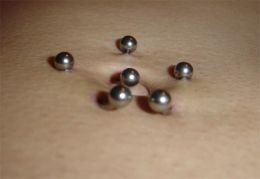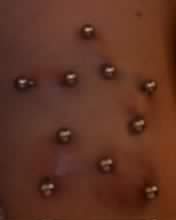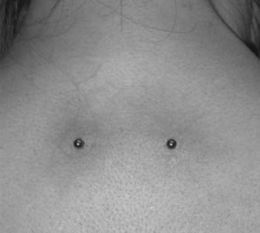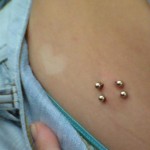Need to go for a body piercing but do not want something too deep? You can try out Surface Piercing. Read on to know all about Surface Piercing, know how it is done and how should care for it.
What is a Surface Piercing?
Page Contents
- 1 What is a Surface Piercing?
- 2 How Is A Surface Piercing Done?
- 3 Surface Piercing Kit
- 4 Surface Piercing Locations
- 5 Surface Piercing Pain
- 6 Surface Piercing Bleeding
- 7 Surface Piercing Aftercare
- 8 Surface Piercing Infection
- 9 Surface Piercing Jewelry
- 10 Surface Piercing Migration
- 11 Surface Piercing Rejection
- 12 How To Stop A Surface Piercing From Rejecting?
- 13 How Long Does A Surface Piercing Last?
- 14 Surface Piercing Prices
- 15 Surface Piercing Pictures
Surface Piercing is a kind of body piercing that is done on the surface of the skin. In case of a Surface Piercing, two holes are created on the same skin plane. The piercing does not travel too deep and penetrates the skin only a little.
Much like other types of body piercing, Surface Piercing is done to let the piercee wear jewelries and make a fashion statement.
How Is A Surface Piercing Done?

Picture 1 – Surface Piercing
Source – whitney05.hubpages.com
Choose a reputed body piercing studio and find out how good its services are. If you do not have feedbacks from a friend or someone you know, it is best to look up on the internet. Try to know if the services are really good. If possible, you should check out studios and piercers personally to ensure accuracy of services.
Fix up an appointment with the studio and turn up at the exact hour on the right day. This will help you get full attention of a professional piercer.
Show the piercer where exactly you want to have a piercing. It is best to choose an area that involves minimal use and contact with rough surfaces. The piercer will mark the entry and exit points with a surgical pen.
Consult your piercer regarding the kind of jewelry you should wear on the pierced spot. Surface Piercing jewelry is usually in the shape of a stapler.
Next, the piercer will clean the area with an antibacterial solution and sterilize it. This will prevent infection in the region after perforation.
The skin may be clamped to ensure safe passing of the needle through the region. But some piercers may carry out the perforation without a clamp to make sure correct needle position on the surface. This can be a little painful though, as the needle takes long to pass through the holes in such case.
The jewelry will be then inserted into the perforation and fastened.
This will be followed with another cleaning session. All traces of blood will be carefully removed and the region will be disinfected to avoid chances of infection.
Note: If your piercer insists on a regular barbell you are probably dealing with an inexperienced person. Find another professional.
Surface Piercing Kit
The Surface Piercing accessories in a piercer’s kit mainly includes a surgical needle, clamps, anchors, antibacterial solutions, cotton pad, disinfectants and a surgical marker.
Surface Piercing Locations
You can commonly find Surface Piercing on face, Surface Piercing next to ear and Surface Piercing on neck. Surface Piercing on chest and Surface Piercing on hip are also quite common. Surface Piercing under belly button is also considered to be very fashionable.
Surface Piercing Pain
In case of Surface Piercing, pain depends on the location of perforation. Collar bone Surface Piercing or chest Surface Piercing can be very painful. Any kind of facial Surface Piercing can also be quite hurtful. Finger Surface Piercing, Hip Surface Piercing and Wrist Surface Piercing do not involve too much pain.
Surface Piercing Bleeding
In Surface Piercing, there is minimal bleeding. An inexperienced hand can however, lead to much blood loss. If you have little knowledge of Surface Piercing, it is not advisable to try it at home. A professional piercer will take care that there is little blood loss. The area will also be cleaned after perforation.
Surface Piercing Aftercare
Surface Piercing care mainly consists of salt water soaks and protecting the surface from injury or irritation.
Salt Water Treatment
Form a saline solution by adding one tsp salt into a glass of warm water. Mix it thoroughly. Soak a cotton ball with a little of this solution. Press it for a few seconds against the recently perforated area and throw away. Use another cotton ball and repeat the process. Do this for 5-10 minutes twice daily.
Avoid Injuries
Guard the recently pierced area from injuries. Try to keep it away from contact with harsh surfaces and avoid playing with your jewelry. It can lead to cases of rejection and migration. Even injuring the surface long after healing can result in migration.
Avoid irritation
If your normal soap causes an irritation in the area, try a mild soap brand instead. Strong soaps are often seen to irritate a recently injured or perforated skin region.

Picture 2 – Surface Piercing Photo
Source – rankmytattoos.com
Surface Piercing Infection
Not taking good care of a Surface Piercing can give rise to infection. Allowing dirt and gems to settle on the pierced area can lead to redness, swelling and pus-filled vesicles in the region. It is normal to have redness and inflammation for 2-4 days after perforation. There may also be a little drainage in the spot for some days. But if this continues for more than 7 days, it is most probably a case of infection.
Surface Piercing infection requires immediate medical care. It is best to consult a dermatologist or some similar professional healthcare giver to carry out treatment.
Surface Piercing Jewelry
As aforesaid, Surface Piercing Jewelry is usually a staple bars. Tygon is a very famous Surface Piercing ornament. It looks like plastic tube with beads fixed at both ends. But if you are looking for a temporary piercing, you can try using a curved barbell. Teflon Surface Piercing bars can be used on nape.
Surface Piercing Migration
Using a heavy jewelry on the pierced spot can lead to Surface Piercing migration. In such cases, the entire perforated area moves from its actual spot and ends up elsewhere taking the jewelry along with it. This is one of the negative results of Surface Piercing.
Surface Piercing Rejection
In some cases, piercees suffer from Surface Piercing rejection. In such situations, the body reacts against the inserted jewelry. The skin pushes the jewelry making it fall out eventually.
Some of the well known Surface Piercing rejection signs are redness and swelling. Discharge is also common in some cases. The entire region is hurtful and gives rise to discomfort.
How To Stop A Surface Piercing From Rejecting?
Surface Piercing rejection can be prevented by using jewelries with a bigger anchor that lets the skin some space to heal. Smaller ornaments are also quite helpful in preventing cases of rejection. After rejection in Surface Piercing scars may appear on the skin and remain for a long time. Unless properly treated, Surface Piercing scarring may become permanent.
How Long Does A Surface Piercing Last?
So how long does a Surface Piercing take to heal? Surface Piercing healing time varies from person to person. A perforation on skin surface usually takes around 6-9 months to heal. Surface Piercing pain generally goes away in 4-8 weeks.
Surface Piercing Prices
A session of Surface Piercing costs somewhere between $45 and $60. The anchors come at anywhere in the $2 – $25 price-range. There are also costlier jewelries made of expensive materials.
Surface Piercing Pictures
Want to get a visual idea of Surface Piercing? Check out these Surface Piercing pictures and find out how a skin region looks after perforation.

Picture 3 – Surface Piercing Picture
Source – whitney05.hubpages.com
Picture 4 – Surface Piercing Image
Source – greatpiercingshop.com
Hope this Surface Piercing information helps you get a safe, clean perforation. Try a reputed piercing studio to get good services. A Surface Piercing experience is usually an enjoyable one and it ultimately depends on you to ensure the success of your session.
References:
http://en.wikipedia.org/wiki/Surface_piercing
http://www.ehow.com/how_2125401_surface-piercing.html
http://www.mookychick.co.uk/style/surface-piercings.php
http://body-jewelry-guide.com/surface-piercing.html
http://www.suite101.com/content/common-surface-piercings-a120638

